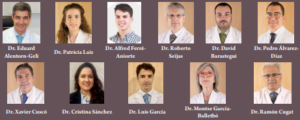Multilineage-differentiating Stress-enduring (MUSE) Cells in Orthobiologics: Are they the Future?
Review Article | Volume 1 | Issue 1 | JRS December 2021 | Page 44-47 | Eduard Alentorn-Geli, Patricia Laiz, Alfred Ferré-Aniorte, Roberto Seijas, David
Barastegui, Pedro Álvarez-Díaz, Xavier Cuscó, Cristina Sánchez, Luís García, Montse García-Balletbó, Ramón Cugat. DOI: 10.13107/jrs.2021.v01.i01.023
Author: Eduard Alentorn-Geli [1,2,3], Patricia Laiz [1,2], Alfred Ferré-Aniorte [1,2], Roberto Seijas [1,2], David Barastegui [1,2,3], Pedro Álvarez-Díaz [1,2,3], Xavier Cuscó [1,2], Cristina Sánchez [1,2], Luís García [1,2], Montse García-Balletbó [1,2], Ramón Cugat [1,2,3]
[1] Instituto Cugat, Hospital Quironsalud. Plaza Alfonso Comín 5-7, Planta -1, 08027 Barcelona, Spain.
[2] Fundación García Cugat, Plaza Alfonso Comín 5-7, Planta -1, 08027 Barcelona, Spain. Barcelona, Spain.
[3] Mutualidad de Futbolistas (Real Federación Española de Fútbol), Delegación catalana. Ronda Sant Pere 19-21, Entresuelo, 08010, Barcelona, Spain.
Address of Correspondence
Dr. Ramón Cugat Bertomeu, MD, PhD,
Instituto Cugat, Plaza Alfonso Comín 5-7, 08023 Barcelona, Spain.
E-mail: ramon.cugat@sportrauma.com
Abstract
Multilineage-differentiating stress-enduring (MUSE) cells are non-tumorigenic pluripotent stem cells with endogenous reparative properties. These cells have a very powerful ability to adapt to global environment changes and are thus stress-tolerant cells. Interestingly, MUSE cells can differentiate into cells representative of all three germ layers. There has been a number of studies demonstrating its powerful regenerative power in several disorders: type-1 diabetes mellitus, myocardial infarction, stroke, glomerular-related kidney diseases, chronic liver failure, and ischemia-reperfusion lung injury. Recent data have also suggested that MUSE cells have significant repair properties for osteochondral lesions. The present article will review what are MUSE cells and how they work, the application of these cells into different disorders, and the studies up-to-date regarding MUSE cells in orthobiologic.
Keywords: Muse cells, stem cells, regenerative, regeneration.
References:
1. Dezawa M. Muse cells. In: Endogenous Reparative Pluripotent Stem Cells. Japan: Springer; 2018.
2. Mahmoud EE, Kamei N, Shimizu R, Wakao S, Dezawa M, Adachi N, et al. Therapeutic potential of multilineage-differentiating stress-enduring cells for osteochondral repair in a rat model. Stem Cells Int 2017;2017:8154569.
3. Kuroda Y, Kitada M, Wakao S, Nishikawa K, Tanimura Y, Makinoshima H, et al. Unique multipotent cells in adult human mesenchymal cell populations. Proc Natl Acad Sci U S A 2010;107:8639-43.
4. Yamada Y, Wakao S, Kushida Y, Minatoguchi S, Mikami A, Higashi K, et al. S1P-S1PR2 axis mediates homing of muse cells Into damaged heart for long-lasting tissue repair and functional recovery after acute myocardial infarction. Circ Res 2018;122:1069-83.
5. Iseki M, Kushida Y, Wakao S, Akimoto T, Mizuma M, Motoi F, et al. Muse cells, nontumorigenic pluripotent-like stem cells, have liver regeneration capacity through specific homing and cell replacement in a mouse model of liver fibrosis. Cell Transplant 2017;26:821-40.
6. Uchida N, Kushida Y, Kitada M, Wakao S, Kumagai N, Kuroda Y, et al. Beneficial effects of systemically administered human muse cells in adriamycin nephropathy. J Am Soc Nephrol 2017;28:2946-60.
7. Perone MJ, Gimeno ML, Fuertes F. Immunomodulatory properties and potential therapeutic benefits of muse cells administration in diabetes. In: Dezawa M, editor. MUSE Cells Endogenous Reparative Pluripotent Stem Cells. Tokyo, Japan: Springer; 2018. p. 115-29.
8. Minatoguchi S, Mikami A, Tanaka T, Minatoguchi S, Yamada Y. Acute myocardial infarction, cardioprotection, and muse cells. In: Dezawa M, editor. Muse Cells Endogenous Reparative Pluripotent Stem Cells. Tokyo, Japan: Springer; 2018. p. 153-66.
9. Niizuma K, Borlongan CV, Tominaga T. Application of muse cell therapy to stroke. In: Dezawa M, editor. MUSE Cells Endogenous Reparative Pluripotent Stem Cells. Tokyo, Japan: Springer; 2018. p. 167-86.
10. Uchida A, Sakata H, Fujimura M, Niizuma K, Kushida Y, Dezawa M, et al. Experimental model of small subcortical infarcts in mice with long-lasting functional disabilities. Brain Res 2015;1629:318-28.
11. Uchida H, Morita T, Niizuma K, Kushida Y, Kuroda Y, Wakao S, et al. Transplantation of unique subpopulation of fibroblasts, muse cells, ameliorates experimental stroke possible via robust neuronal differentiation. Stem Cells 2016;34:160-73.
12. Uchida H, Niizuma K, Kushida Y, Wakao S, Tominaga T, Borlongan CV, et al. Human muse cells reconstruct neuronal circuitry in subacute lacunar stroke model. Stroke 2017;48:428-35.
13. Uchida N, Kumagai N, Kondo Y. Application of muse cells therapy for kidney disease. In: Dezawa M, editor. MUSE Cells Endogenous Reparative Pluripotent Stem Cells. Tokyo, Japan: Springer; 2018. p. 199-218.
14. Nishizuka SS, Suzuki Y, Katagiri H, Takikawa Y. Liver regeneration supported by muse cells. In: Dezawa M, editor. Muse Cells Endogenous Reparative Pluripotent Stem Cells. Tokyo, Japan: Springer; 2018. p. 219-41.
15. Yabuki H, Wakao S, Kushida Y, Dezawa M, Okada Y. Human multilineage-differentiating stress-enduring cells exert pleiotropic effects to ameliorate acute lung ischemia-reperfusion injury in a rat model. Cell Transplant 2018;1:963689718761657.
16. Yabuki H, Watanabe T, Oishi H, Katahira M, Kanehira M, Okada Y. MUSE cells and ischemia-reperfusion lung injury. In: Dezawa M, editor. MUSE Cells Endogenous Reparative Pluripotent Stem Cells. Tokyo, Japan: Springer; 2018. p. 293-303.
17. Yamashita T, Kushida Y, Wakao S, Tadokoro K, Nomura E, Omote Y, et al. Therapeutic benefit of Muse cells in a mouse model of amyotrophic lateral sclerosis. Sci Rep 2020;10(1):17102.
18. Toyoda E, Sato M, Takahashi T, Maehara M, Nakamura Y, Mitani G, et al. Multilineage-differentiating stress-enduring (Muse)-like cells exist in synovial tissue. Regen Ther 2019;10:17-26.

| How to Cite this article: Geli EA, Laiz P, Aniorte AF, Seijas R, Barastegui D, Díaz PÁ, Cuscó X, Sánchez C, García L, Balletbó MG, Ramón Cugat R | Multilineage-differentiating Stress-enduring (MUSE) Cells in Orthobiologics: Are they the Future? | Journal of Regenerative Science | Dec 2021; 1(1): 44-47. |
